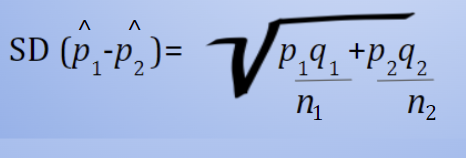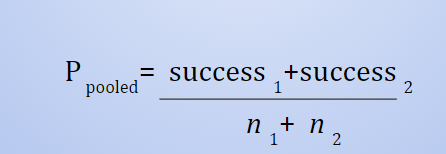Comparing 2 Proportions
1/11
There's no tags or description
Looks like no tags are added yet.
Name | Mastery | Learn | Test | Matching | Spaced |
|---|
No study sessions yet.
12 Terms
In contrast to one-proportion problems, 2-proportion problems..
give 2 different groups (no baseline or null → need to COMPARE the 2 groups)
Standard Deviation of the Difference b/w 2 proportions
SD(p-hat(1) - p-hat(2))= sqr( (p1q1/n1) + (p2q2/n2)

Assumptions and Conditions
Independent Assumption (w/in each group)
Success/Failure Condition
Independent Group Assumption (b/w groups)
Randomization Condition
10% Condition
Independent Group Assumption
The 2 groups we’re comparing must be independent of each other (most important assumption, if violated then the methods won’t work)
PANIC for difference b/w 2 proportions
Parameter of interest: “Im interested in determining how effective ___ is”
Assumptions and Conditions: Independence and Independence Group Assumption, Randomization Condition, 10% Condition, Success/Failure Condition
Name Interval: “B/c my conditions are satisfied I can use a Normal Model to construct a 2-propotion z-interval”
Interval Calculation: 1st identify variables (p1,n1,p2,n2) → CI: estimate (p-hat(1) - p-hat(2)) ± ME (z* x SE(p-hat(1) - p-hat(2))
Conclusion in Context: “Im #% confident that ___ could affect the proportion b/w (CI lower bound)% and (CI upper bound)%
Null Hypothesis for Difference b/w 2 proportions
H0: p1=p2 or p1-p2=0 [Hypothesizing that there’s NO difference in the proportions)

Pooling
combining counts to get an estimated overall proportion
Pooled proportion
P(pooled)= (sucess1 + success2)/ n1+n2

SE for 2 proportion z-test
SEpooled (p1-p2)= sqr( (p(pooled) x q(pooled))/n1) + (p(pooled) x q(pooled))/n2)

PHANTOMS for difference b/w 2 proportions
Parameter of Interest is same as CI
Hypotheses: H0: p1-p2=0; HA: p1-p2 does NOT equal 0 (can be inequalities such as < and >)
Assumptions and Conditions is same as CI
Name Test: “B/c my conditions are satisfied I can use a Normal Model to construct a 2-propotion z-test”
Test Statistic: calculate p(pooled) and SE(pooled(p1-p2) to get z-score ( ((p1-p2)-0/H0)/SEpooled(p1-p2)
Obtain P-value: P(z(inequality) z-score)
Make a Decision: “W/ a P-value so low/high, I will(low)/ wont (high) reject H0. If H0 were true, I would see the observed difference I have (P-value as %) of the time”
State Conclusion in Context: “ There is(low)/isnt(high) strong evidence that there’s an effect w/ the modification
If we have an experiment where the groups result from random allocation of subjects into treatments..
Independent Group Assumption is NOT reasonable
What can go wrong?
Dont use 2 sample proportion methods when the samples arent independent
Dont apply inference methods when there’s no randomization
Dont interpret the significant different of proportions causally